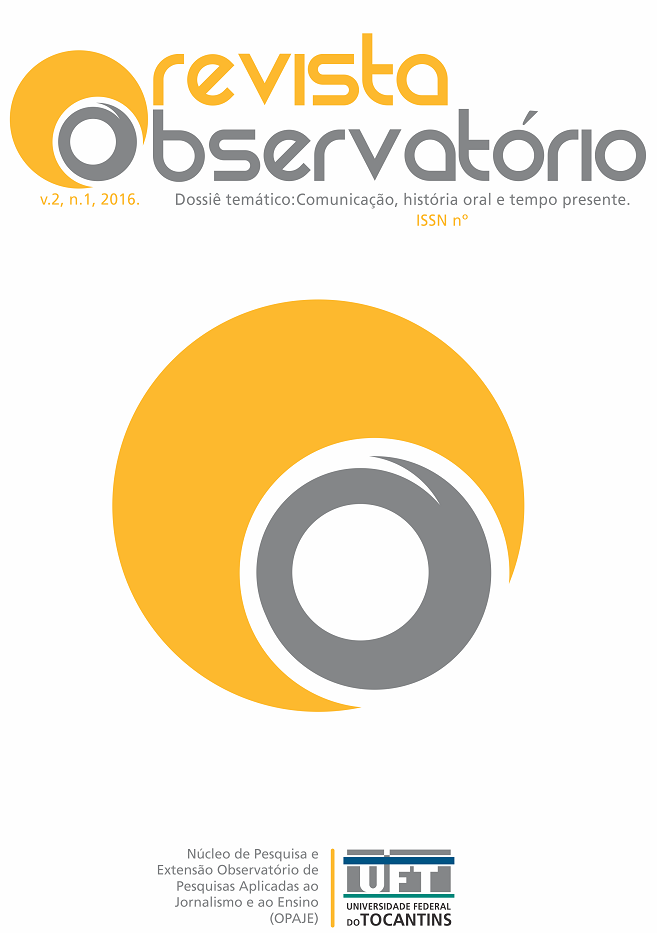Memória Massacre Carandiru: a digital public history against oblivion
DOI:
https://doi.org/10.20873/uft.2447-4266.2016v2n1p92Keywords:
Massacre, digital public history, memory, CarandiruAbstract
This article discusses the concept of digital public history and its importance through the presentation of portal Memória Massacre Carandiru. Initially as film researchers O Homem da Grade de Ferro (2003 ), which deals with oral and imagistic narrative of prisoners Carandiru complex, we contacted the creators and organizers of the site, which aims to bring together the largest number of documents - iconographic, legal, journalistic, filmic and oral - for the massacre in the Penitentiary of São Paulo, in 1992, and make them available to an audience and public debate. The project also intends to create a collection of oral narratives of the subjects involved in the event, valuing the memory forgotten/prevented on historical trauma, still not properly addressed.
Downloads
References
ALMEIDA, Juniele R.; ROVAI, Marta G. O. Introdução à História Pública. São Paulo: Letra e Voz, 2011.
ARAÚJO, Maria P.; SANTOS, Myrian S. História, memória e esquecimento: Implicações políticas. Revista Crítica de Ciências Sociais, n.79, Dezembro/2007, p. 95-111.
BAUMAN, Zygmunt. Identidade: entrevista a Benedetto Vecchi. Rio de Janeiro: Zahar, 2005.
BENJAMIN, Walter. Obras escolhidas. Magia e técnica, arte e política. Ensaios sobre literatura e história da cultura. Vol. 1, São Paulo: Brasiliense, 1987.
ESQUIROL, Josep M. O respeito ou o olhar atento. Belo Horizonte: Autêntica, 2008.
FERNANDES, Simone Silva. Fontes orais: Perspectivas para o tratamento em centros de documentação e arquivos In ALMEIDA, Juniele R; ROVAI, Marta G.O. Introdução à História Pública. São Paulo: Letra e Voz, 2011.
GINZBURG, Jaime. Crítica em tempos de violência. São Paulo: EDUSP, 2012.
HALBWACHS, Maurice. A memória coletiva. São Paulo: Vértice, 2006.
JELIN, Elizabeth. Los trabajos de la memória. Madrid/Buenos Aires: Siglo XXI, 2001.
NOIRET, Serge. História Pública Digital. Liinc em Revista, Rio de Janeiro, v.11, n.1, maio 2015, p. 28-51.
NORA, Pierre. Entre memória e história: a problemática dos lugares. Projeto História. n.10, dez 1993, p. 7-28.
POLLAK, Michael. Memória, esquecimento e silêncio. Estudos Históricos, Rio de Janeiro, 2 (3), 1989, p .3-15.
RICOEUR, Paul. A memória, a história, o esquecimento. Campinas: Unicamp, 2007.
ZAHAVI, Gerald. Ensinando história pública no século XXI In ALMEIDA, Juniele R.; ROVAI, Marta G. O. Introdução à História Pública. São Paulo: Letra e Voz, 2011.
Downloads
Published
How to Cite
Issue
Section
License
[PT] Autores que publicam nesta revista concordam com os seguintes termos:
1. Autores mantém os direitos autorais e concedem à revista, sem pagamento, o direito de primeira publicação, com o trabalho simultaneamente licenciado sob a Creative Commons Attribution License (CC BY-NC 4.0), permitindo o compartilhamento do trabalho com reconhecimento da autoria do trabalho e publicação inicial nesta revista.
Leia todos os termos dos direitos autorais aqui.

